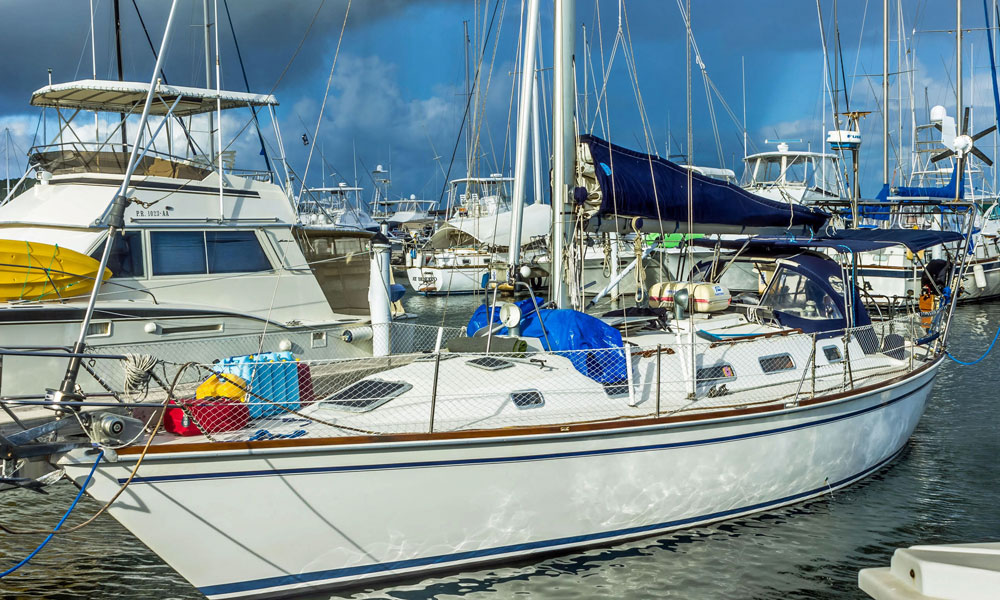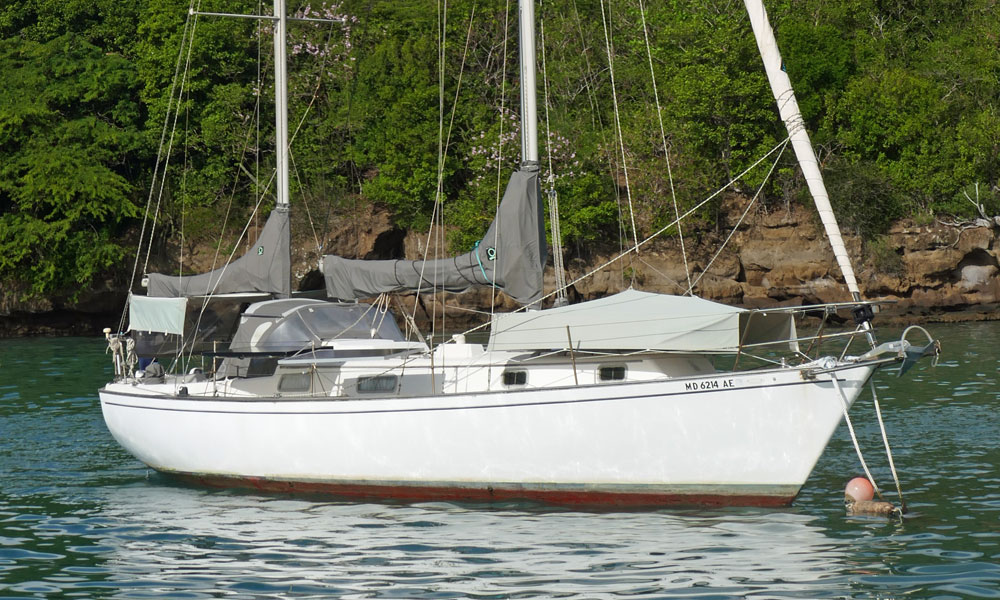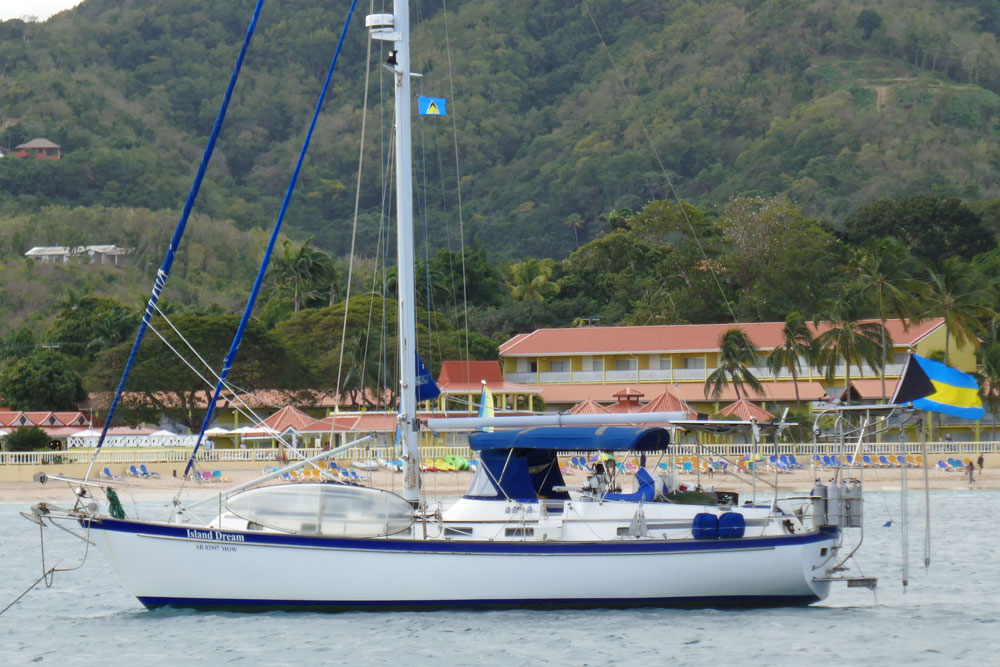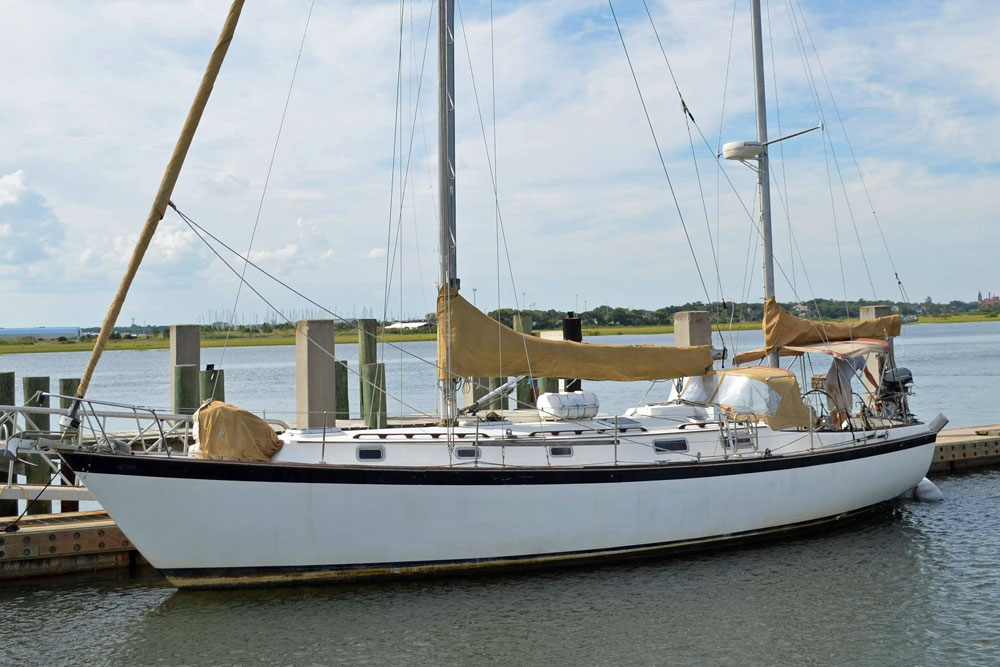- Home
- Cruising Yachts 35' to 40'
- Pearson 39-2
The Pearson 39-2 Sailboat
The Pearson 39-2, a sailboat designed by the American naval architect William H. Shaw, epitomizes a blend of comfort and sailing performance. Built by Pearson Yachts, which was located in Portsmouth, Rhode Island, the production of this model spanned from 1986 to 1991.
This yacht serves as a hallmark of the later era of Pearson’s production, reflecting Shaw’s design philosophy that balances ease of handling with robust, seaworthy construction. The builder, Pearson Yachts, was renowned for its significant contributions to fiberglass boat manufacturing, playing a pivotal role in the popularization of this material in yacht construction.
 Many thanks to Crystal and Rob Bleecher for this pic of their Pearson 39-2.
Many thanks to Crystal and Rob Bleecher for this pic of their Pearson 39-2.Published Specification for the Pearson 39-2
- Underwater Profile: Fin keel and spade rudder
- Hull Material: GRP (Fiberglass)
- Length Overall: 39'3" (12.0m)
- Waterline Length: 31'3" (9.5m)
- Beam: 12'5" (3.8m)
- Draft: 6'10" (2.1m)
- Rig Type: Masthead Sloop
- Displacement: 16,800lb (7,620kg)
- Designer: William Shaw
- Builder: Pearson Yachts (USA)
- Year First Built: 1986
- Year Last Built: 1991
There were two other versions of the Pearson 39-2: a centreboard version with a draft of 4.67’/2.67m (board up), 8.75’/2.67m (board down) and a wing keel version with a draft of 5.33’/1.62m.
Published Design Ratios for the Pearson 39-2
The Pearson 39-2 sailboat, based on its design ratios, seems designed to offer a balanced performance between speed, stability, and comfort, suitable for versatile cruising experiences. Here’s a detailed analysis based on the provided ratios:
- Sail Area/Displacement Ratio: 18.2 - This ratio indicates that the Pearson 39-2 is capable of reasonable performance. With a ratio between 16 to 20, it suggests the sailboat has decent power for its weight. This means the boat should be able to handle a variety of conditions with adequate speed and agility, making it a good choice for cruisers who also enjoy a zest of sailing performance.
- Ballast/Displacement Ratio: 40.5 - This high ratio implies that the Pearson 39-2 is stiff and powerful, meaning it should handle well in winds without heeling too excessively. This contributes to both the vessel's safety and performance. However, it’s important to note the limitation of this ratio not considering the distribution of the ballast. If the ballast is not optimized in terms of placement, it may affect the boat’s overall performance and safety.
- Displacement/Length Ratio: 246 - This moderate displacement indicates that the Pearson 39-2 is neither a light nor heavy displacement boat but falls in the moderate category. This suggests the boat is capable of providing a good balance between manageable handling and robustness in various sea conditions. It should be responsive enough while remaining capable of carrying sufficient provisions and equipment for longer trips.
- Comfort Ratio: 26.9 - Falling within the 20 to 30 range, the Comfort Ratio shows the boat is likely to exhibit motion characteristics associated with a typical coastal cruiser - stable but with moderate motion in seas. While it may not be as comfortable in rough waters as heavier displacement vessels, it is suited for a wide range of conditions typically faced by recreational and long-distance coastal sailors.
- Capsize Screening Formula: 1.9 - With a result under 2.0, the Pearson 39-2 appears to be suited for ocean passages, indicating a good level of safety in terms of stability and capsize resistance. This ratio supports the boat's use in more challenging conditions and enhances its appeal to cruisers aiming for longer or more demanding trips.
Read more about Design Ratios...
Theoretical Considerations:
The theoretical analysis provides insights but must be taken with due consideration of practical variances and individual boat conditions. Especially, the Ballast/Displacement Ratio should be explored in context with ballast placement and hull design specifics, as a centrally concentrated ballast lowers the center of gravity, thereby enhancing stability more effectively than a shallow placement.
Furthermore, while Ted Brewer's Comfort Ratio provides a helpful general guideline, modern designs often balance beam and displacement differently to achieve stability and comfort without strictly following traditional configurations implied by the ratio.
In summary, the Pearson 39-2 according to these design ratios, offers a balanced performance suitable for robust cruising with good speed, handling, and adequate comfort, tailored for sailors who long for a mixing of performance and leisure in varying conditions.
The above text was drafted by sailboat-cruising.com using GPT-4 (OpenAI’s large-scale language-generation model) as a research assistant to develop source material; we believe it to be accurate to the best of our knowledge.
Other sailboats in the Pearson range include:
Recent Articles
-
Modern Boat Electronics and the Latest Marine Instruments
Dec 20, 25 05:27 PM
Should sailboat instruments be linked to the latest boat electronics as a fully integrated system, or is it best to leave them as independent units? -
Hans Christian 43: Classic Bluewater Cruiser & Liveaboard Sailboat
Dec 10, 25 04:37 AM
Explore the Hans Christian 43: a legendary heavy-displacement, long-keel sailboat. Read our in-depth review of its specs, design ratios, and suitability for offshore cruising and living aboard. -
Planning Your Sailboat Liveaboard Lifestyle: An Ocean Sailor's Guide
Dec 06, 25 05:18 AM
Seasoned sailors share their methodical risk analysis for planning a secure Sailboat Liveaboard Lifestyle, covering financial, property, and relationship risks.















